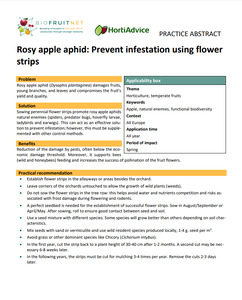{Tool} Rosy apple aphid: Prevent infestation using flower strips (Biofruitnet Practice Abstract). Creator(s): Pedersen, Hanne Lindhard and Bojesen, Maya. Issuing Organisation(s): HortiAdvice. Biofruitnet Practice Abstract, no. 019. (2022)
|
PDF
- Published Version
- English
(Rosy apple aphid: Prevent infestation using flower strips)
415kB | |
![[thumbnail of 2022-07-01 14_22_32-Rosy apple aphid_ Prevent infestation using flower strips.png]](/44181/3.hassmallThumbnailVersion/2022-07-01%2014_22_32-Rosy%20apple%20aphid_%20Prevent%20infestation%20using%20flower%20strips.png)  Preview |
Image (PNG)
- Cover Image
- English
118kB |
|
PDF
- Published Version
- Danish/Dansk
(Rød æblebladlus: Forebyg angreb ved hjælp af blomsterstrimler)
417kB | |
|
PDF
- Published Version
- Polish/Polski
(Mszyca jabłoniowo-babkowa: ograniczanie występowania za pomocą pasów kwiatowych)
421kB |
Document available online at: https://orgprints.org/44181
Summary in the original language of the document
Reduction of the damage by pests, often below the economic damage threshold. Moreover, it supports bees (wild and honeybees) feeding and increases the success of pollination of the fruit flowers.
Practical recommendation: 1) Establish flower strips in the alleyways or areas besides the orchard. 2) Leave corners of the orchards untouched to allow the growth of wild plants (weeds). 3) Do not sow the flower strips in the tree row: this helps avoid water and nutrients competition and risks associated with frost damage during flowering and rodents. 4) A perfect seedbed is needed for the establishment of successful flower strips. Sow in August/September or April/May. After sowing, roll to ensure good contact between seed and soil. 5) Use a seed mixture with different species. Some species will grow better than others depending on soil characteristics. 6) Mix seeds with sand or vermiculite and use wild resident species produced locally, 1-4 g. seed per m2. 7) Avoid grass or other dominant species like Chicory (Cichorium intybus). 8) In the first year, cut the strip back to a plant height of 30-40 cm after 1-2 months. A second cut may be necessary 6-8 weeks later. 9) In the following years, the strips must be cut for mulching 3-4 times per year. Remove the cuts 2-3 days later.
| EPrint Type: | Practice tool |
|---|---|
| What problem does the tool address?: | Rosy apple aphid (Dysaphis plantaginea) damages fruits, young branches, and leaves and compromises the fruit's yield and quality. |
| What solution does the tool offer?: | Sowing perennial flower strips promote rosy apple aphids natural enemies (spiders, predator bugs, hoverfly larvae, ladybirds and earwigs). This can act as an effective solution to prevent infestation; however, this must be supplemented with other control methods. |
| Country: | Denmark |
| Type of Practice Tool: | Practice abstracts |
| Keywords: | Apples, natural enemies, functional biodiversity |
| Agrovoc keywords: | Language Value URI English apples http://aims.fao.org/aos/agrovoc/c_541 English natural enemies http://aims.fao.org/aos/agrovoc/c_5085 English biodiversity http://aims.fao.org/aos/agrovoc/c_33949 |
| Subjects: | Environmental aspects > Biodiversity and ecosystem services Crop husbandry > Production systems > Fruit and berries Crop husbandry > Crop health, quality, protection |
| Research affiliation: | European Union > Horizon 2020 > Biofruitnet Denmark > Other organizations Denmark European Union > Organic Farm Knowledge |
| Horizon Europe or H2020 Grant Agreement Number: | 862850 |
| Related Links: | https://organic-farmknowledge.org/tool/44181, https://biofruitnet.eu, https://twitter.com/farm_knowledge/status/1584448757986271233, https://www.facebook.com/organicfarmknowledge/posts/pfbid02xhMx3fnqBaS88U1kJeZyT8SjKMyFGUGQ4y2g5Ty2VLZAk6v9mdchf5tqsYKwGfpwl |
| Project ID: | ofk |
| Deposited By: | Basler, Andreas |
| ID Code: | 44181 |
| Deposited On: | 23 Jun 2022 09:24 |
| Last Modified: | 02 May 2024 10:32 |
| Document Language: | English, Danish/Dansk, Polish/Polski |
| Status: | Published |
Repository Staff Only: item control page


